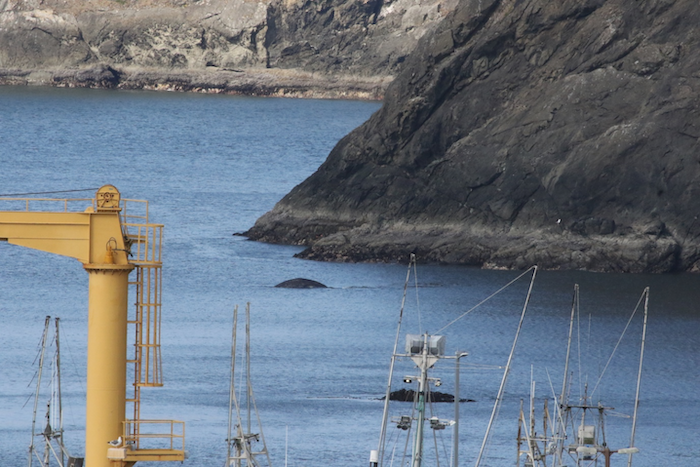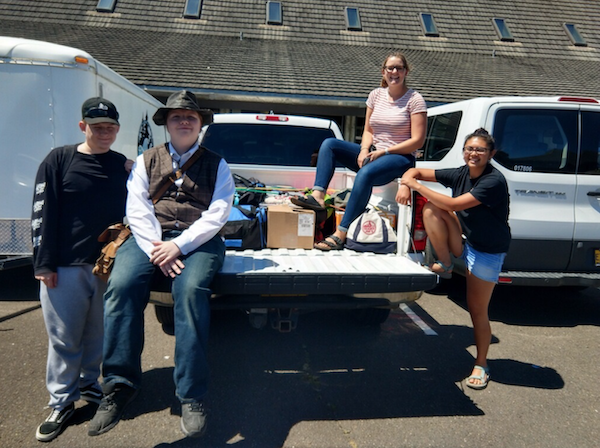By Mia Arvizu, Marine Studies Initiative (MSI) & GEMM Lab summer intern, OSU junior
Part 1: The Green Life Jacket
The swells are churning and for once my stomach is calm. I take advantage of it while I can, and head out on the kayak. Another beautiful day, another good data set. After about three hours in the kayak and a long paddle fighting winds and swells, we arrive at TC1. That’s short for Tichenor Cove Station 1. I’m fairly tired by now but my teammate and I are determined to finish all stations today. GPS says we arrived, and I paddle against any slight movement to keep us on station. It’s getting more difficult though, so I check in with Anthony, one of the high school interns this summer. “Anthony, have you sent the GoPro camera down yet?” I take a quick look back peering over my green life jacket. Red flash, and I know it’s on. Anthony sends it down, and I watch as it plunges into depths I couldn’t see on my own. I’m confident it’s doing its job.


Kayaking on the Port Orford coast collecting prey data on the foraging ecology of whales and collecting information on the abundance of sea urchins. Source: A. Howe.
Part 2: The GoPro Dive
The green life jacket is familiar, but there’s a different soul, a different face every year. It’s the same month though. August – the month of whales.
Red flash, I’m on, and it’s my time to shine. The scientists debrief me on my latest mission, and I’m alive. “Secchi depth .75 meters.” Hmm, low visibility. This may be a tough one. “Station TC1” One of my favorites but challenging no doubt. “Time is 10:36. 5, 6, 7, 8…” I’m ready. A flush of swirling water surrounds me as I plunge into the depths of a different realm. I’m cocooned in the beauty of an ocean so blue, so majestic, so entrancing. Oh, the mission! Right, I need to stay focused. They lurk all around but with sand clouding the water, I can barely see. I just need one good visual of the purple spikes and the swaying green leaves, and the mission will be complete. I glance just to the left and oh my!

A giant purple spike comes too close. I barely caught a glimpse of it. I need a better shot, but I only have so much control especially with these undercurrents. I’m ready now though. I peer through the sediment and nothing, but one quick swivel to the right shows me what I feared and what the green life jackets predicted: The purple spikes have grown too many and reduced the swaying greens down to half chewed, severed, scared dead masses. I thought their hypothesis was right, but I didn’t expect this degree of damage. It’s so frightening I almost look away.
But I don’t. I have a mission. So, I look straight ahead documenting the scene. I haven’t seen it this bad in the past years. I wonder what the green life jackets will do about this. I feel a tug, and I’m reeled in. I guess I’ll find out.
Part 3: The Science, how I see it
After collecting data in the kayak, I go back to the field station ready to do data processing. I grab the GoPro and take a look at the video from TC1. I’m both amazed and terrified for the surrounding habitat from what I see. Sea urchins seem to have been actively foraging on kelp stalks.
Last summer, around this time, a previous intern pointed out that he was witnessing damaged kelp and a notable number of urchins in the GoPro videos. Thus, the GEMM Lab is looking into the relationship between kelp health and sea urchin abundance in Port Orford, which can have significant trophic cascades for the rest of the ecosystem, including whales and their zooplankton prey. The hypothesis is that if sea urchin populations increase in number they may actively forage on kelp, reducing the health of that habitat. Many creatures depend on this habitat including zooplankton which whales feed on. I have looked at videos from past years and the temporal difference in the abundance of urchins is stark. A detailed methodology for the project and our pending results will be featured in a later post, but for now this story is unfolding before our eyes and the GoPro’s lens as well.
Part 4: The Transformation from STEM to STEAM
I hope you enjoyed these short stories. As the writer, it was nice to express the ecological phenomena I’ve learned about in the last few weeks between sea urchins and kelp in this creative and artistic outlet. Especially since I feel science can be rigid at times. It can be easy to lose myself in numbers and large datasets. However, by tying together the arts and STEM (Science, Technology, Engineering, Mathematics), there is more space for well-rounded inquiry and expressive results. STEAM, which is STEM with the Arts included, is not a new movement. Examples of STEAM are preserved in the past and is ongoing in present examples. A great example of how the sciences and arts are merged together is in the songs of Aboriginal Australians. These songs can take hours to recite fully and are full of environmental knowledge such as species types, behavior of animals, and edible plants. The combination of art and STEM is also displayed in the modern age and is shown in Leah Heiss’s work to create jewelry that helps measure cardiac data and also helps diabetics administer their insulin.

There are many ways in which the two subjects can merge together, making each other stronger and better. As a well-rounded student pursuing Environmental Science and interested dance and writing, I am comforted to know that STEAM can allow me to blend my interests.

















You must be logged in to post a comment.